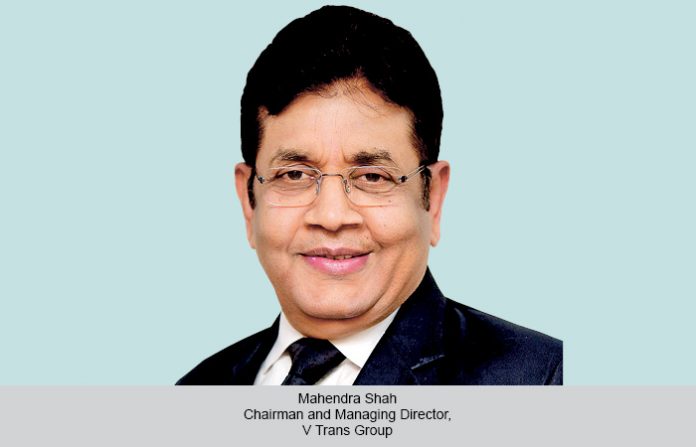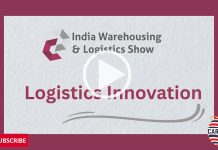We are bridging infrastructure gaps through strategic hub expansion, countering cost pressures with route optimisation, alternate fuel options and EV-readiness and tackling driver crisis with structured skilling programmes, says Mahendra Shah, Chairman and Managing Director, V Trans Group.
CT Bureau
What safety protocols do you follow for cargo handling? Is your team trained in handling hazardous goods?
Our teams undergo structured training for dangerous goods. We do it for certain classes and have specialised storage facilities to store six out of nine classes of hazardous goods. This facility has excellent team and global standards of safety. While moving the goods out, we follow all mandated regulatory compliances. Certified personnel to handle such shipments using specialised equipment and labeling standards. We have institutionalised risk assessments and regular safety audits across our network. For us, cargo safety is not just about compliance—it is about trust, reliability and long-standing reputation.
What industries do you serve?
Our expertise spans across sectors, such as automotives, chemicals, pharma, engineering, electrical, publishing, textiles and consumer electronics among others. Each sector demands precision, compliance and agility—and that is where our multi-vertical structure delivers unmatched value. With V-Trans for surface transport, V-Xpress for time-bound express cargo and V-Logis for warehousing and 3PL services, we offer end-to-end, industry-specific solutions. Our pan-India reach, tech-enabled systems and deep domain expertise allow us to handle complex supply chains with speed and safety.
Tell us about infra and facilities for cost-effective cargo handling and transportation?
Our pan-India network of 1,500 branches, 2,500 advanced GPS-enabled and SIM-based tracking fitted vehicles and more than 3 lakh square feet of technology-integrated warehousing and operations space make our reach and capability strong to handle massive volumes. We handle more than 2.4 tonnes of cargo with 90 million articles each year. We have built high-efficiency hubs and transshipment centres designed for speed, precision and scalability. Our ERP-driven systems, automated handling processes and real-time visibility tools empower seamless cargo flow with reduced cost and enhanced service accuracy. Every asset is optimised for performance and built to scale. This deep-rooted physical and digital infrastructure allows us to
deliver smarter, faster and leaner logistics.
Do you offer real-time inventory visibility and order tracking? Are your systems capable of integrating with third-party ERPs?
Our tech platform, which is named as ‘Vijayant,’ powered by Oracle, stands at the core of it. This enterprise-grade system seamlessly integrates with our best-in-class WMS, TMS and Financial software, and other internal systems and functionalities, offering real-time inventory visibility, dynamic order tracking and intelligent load planning with seamless information flow. Clients get live updates, actionable insights and transparency at every stage. Vijayant is built for agility and easily integrates with third-party ERPs, CRMs, and e-commerce ecosystems through robust APIs. This tech backbone does not streamline operations, it empowers our customers with smarter control, faster TAT and sharper decision-making across the supply chain.
How have PMGS and NLP impacted your operations?
PMGS and NLP have laid the foundation for a unified, tech-driven logistics ecosystem. They have unlocked route optimisation, faster TAT, and multimodal synergies. We are aligning with the national master plan to scale smarter—leveraging digital corridors, freight clusters and policy-driven transparency. These reforms do not support our operations—they amplify our strategic roadmap. As an industry leader, we welcome this shift and are geared up to be a front-runner in Indian logistics transformation story.
What are the crucial pain points? Can you share the solutions?
The logistics sector is navigating structural challenges—uneven infrastructure, rising fuel costs, skilled manpower gaps and fragmented compliance across states. We are bridging infrastructure gaps through strategic hub expansion, countering cost pressures with route optimisation, alternate fuel options and EV-readiness and tackling the driver crisis with structured skilling and internal motivation programmes such as ‘Dignity to Drivers’, benefits and retention programmes. Skilled manpower is being addressed with our intensive training and upskilling programmes.
Are you taking steps to reduce environmental impact by taking up energy-efficient lighting and recyclable materials?
From green logistics to community upliftment, we are committed to building a better tomorrow. Our solar power installations now generate 40 per cent of our corporate office’s energy needs. We are planning to scale them from 700 kW to 2,000 kW across India at our major facilities. Rainwater harvesting, certified e-waste recycling, and LEED-certified infrastructure reinforce our eco-conscious operations. CNG vehicles make up 25 per cent of our fleet, and EVs are being tested for last-mile.
Through NGO partnerships, we have also planted 16,305 fruit-bearing trees yielding 16,000 tonnes of oxygen and segregating 10,000 tonnes of GHG emissions Our ‘Together with Tomorrow’ mission integrates employee wellness, ‘Dignity to Driver’ initiatives, and digitalisation across our branches.















